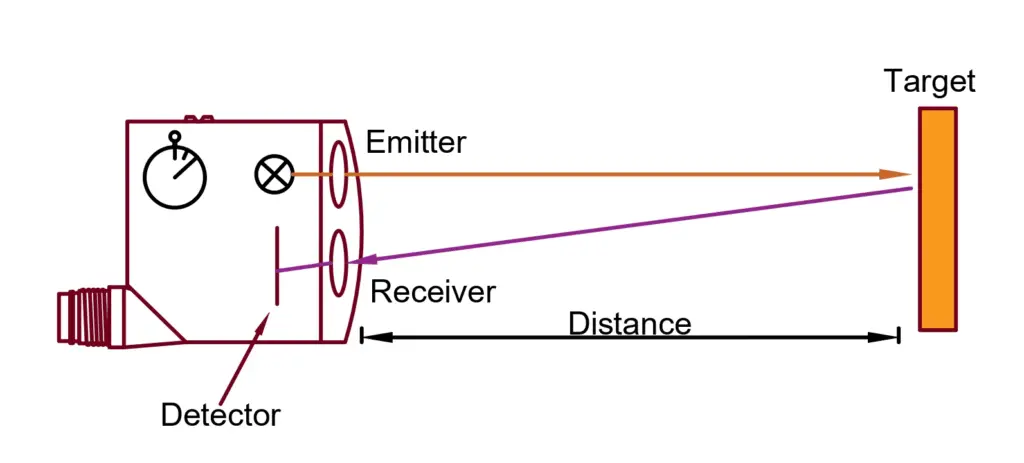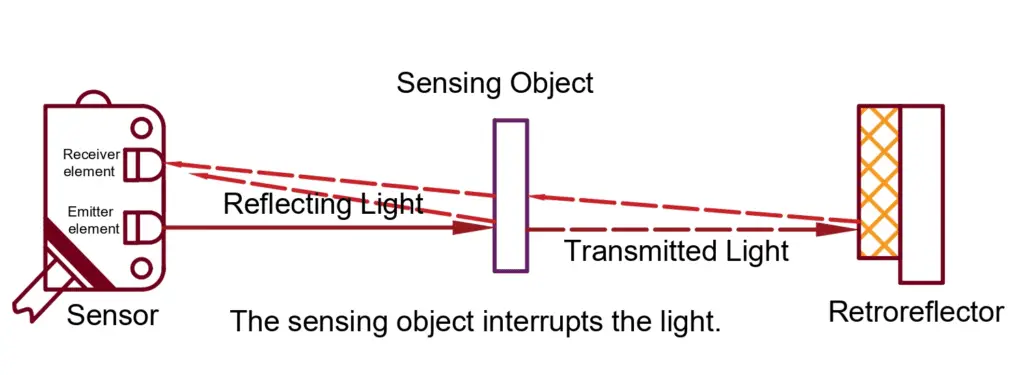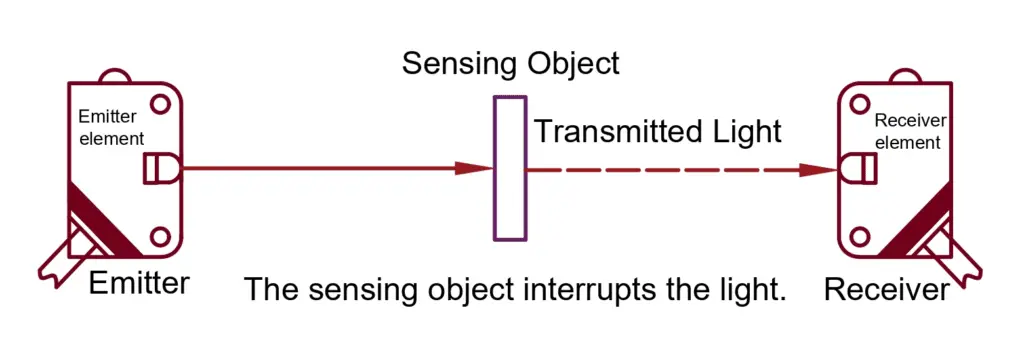A photoelectric sensor is an instrument designed to detect the presence of an object. It also measures the distance of the object from a specific location. The photoelectric sensor uses the light rays such as infrared rays to sense.
A light-emitting element acts as a transmitter that emits light rays. A receiver is placed at the other end of the transmitter. An object cuts the light rays that pass in between the transmitter and receiver transmitter. Therefore, on cutting the light rays by an object, the intensity of light rays reaching the receiver decreases. As a result, the intensity of light received at the receiver can be continuously processed and converted into electrical output. The change in the intensity of light received causes a change in electrical output.
Components of a Photoelectric Sensor
- Light Emitting Element/Transmitter: It is a light source, for example, an LED or a laser diode
- Receiver: It can be a photodiode or a phototransistor that detects the light source
- Supporting electronics: The electronic circuitry used to amplify the signal from the receiver
Types of Photoelectric Sensors
There are three types of photoelectric sensors. They are-
- Laser Photoelectric Sensor
- Fiber Optic Photoelectric Sensor
- Remote Photoelectric Sensor
Let us discuss in detail all three types of sensors
1. Laser Photoelectric Sensors
Laser Photoelectric sensors are used as sensor light sources. They are available in different versions like thru-beam, diffuse scan, and diffuse scan with background suppression. The lasers provide high-intensity visible light, as a result, their assembly and adjustment are easier. It is possible to detect extremely small objects which are at a distance using laser technology.
2. Fiber Photoelectric Optic Sensors
The fiber optic sensors use an emitter, receiver, and flexible cable that has many tiny fibers. The function of these tiny fibers is to transmit light. The emitter source that generates infrared light uses glass fibers for light transmission. And, the emitter source that generates visible light uses plastic fibers for light transmission. These sensors are available in versions like thru-beam, diffuse scan, and diffuse scan with background suppression. These types of sensors are best suited for small sensing areas or for small objects.
3. Remote Sensors
Remote photoelectric sensors are used for remote sensing. They have only the optical components of the sensor.
We can categorize these sensors into three categories on the basis of their working principle. They are:
3a. Diffused Mode or Proximity-sensing Mode
In the diffused mode, the transmitter and receiver are in the same housing. The light from the transmitter will be incident on the target. The target reflects some of the light back to the receiver. The transmitter and receiver are placed at the same end. The output can be NO, NC, NPN, or PNP.

3b. Retro-reflective Mode
In the retro-reflective mode, the transmitter and receiver are both at the same end. A retro-reflector is placed opposite the sensor. When an object blocks the beam of light from the sensor to the reflector, then the sensor detects the object.

3C. Through-beam Mode or Opposed Mode
In this mode, the transmitter and receiver are placed in different housings. When there is no object, the light from the transmitter will reach the receiver. When an object breaks this light beam, an output would be generated.
Through-beam mode or opposed mode is the most efficient mode as compared to the other three. It allows the largest possible sensing range for photoelectric sensors.

Operating modes of photoelectric sensors
There are two operating modes of photoelectric sensors. They are:
1. Dark Operate(DO)
In the dark operate mode, the load would be energized when the light from the emitter is absent from the receiver, that is, the light that is emitted is not received.
2. Light Operate(LO)
In the light operating mode, the load would be energized when the light from the emitter reaches the receiver.
Applications of photoelectric sensors
The different applications of photoelectric sensors are given below:
- Detect changes in the target’s color, contrast, and luminescence
- They are used to detect porous targets and invisible markings on products
- Detect the presence or movement of an object within a defined sensing area or zone
- They are used to locate the position of an automated storage and retrieval system
- Photoelectric sensors are used to check the passage of cars on a conveyor
- They are used to count bottles moving on a high-speed conveyor
Advantages of photoelectric sensors
- Detects all kinds of materials(can detect any object, including glass, plastic, wood, or liquid).
- Long sensor life (Because of no moving contacts)
- Long sensing range
- Reliable
- Fast response time.
- It is a cheaper sensor.
- Diffuse photoelectric sensor detects small objects including color mark and label detection.
- Easy adjustment.
- They do not get affected by object color, gloss, or inclination.
- Simple wiring and optical axis adjustment.
- High resolution.
Disadvantages of photoelectric sensors
- Over course of time, the lens gets contaminated.
- The photoelectric sensor’s sensing range is affected by the color and the reflectivity of the target.
- In the through-beam type, the transmitter (Tx) and receiver (Rx) are at two separate locations. Retro-reflective type requires a reflector in addition to Tx and Rx. This makes system installation complex.